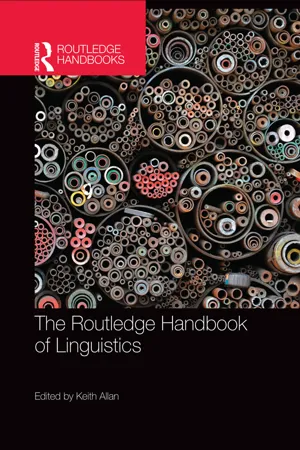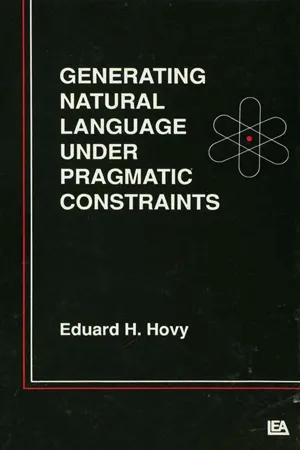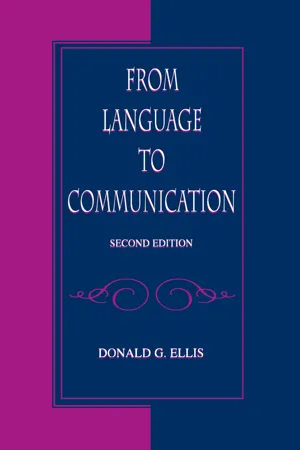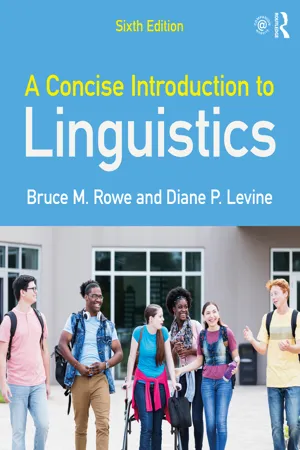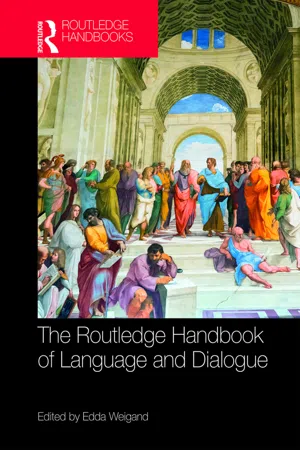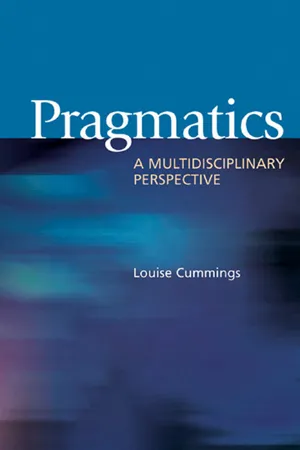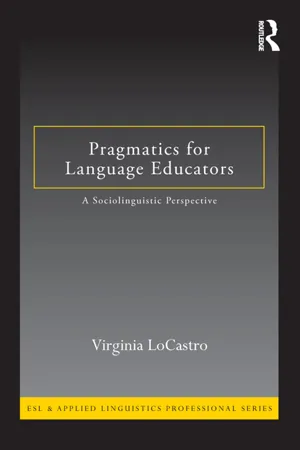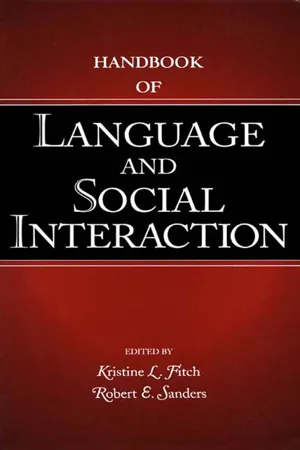Languages & Linguistics
Pragmatics
Pragmatics is the study of how context influences the interpretation of language. It focuses on the ways in which language users understand and produce meaning in real-world situations. This field examines aspects such as speech acts, implicature, and conversational implicature to understand how language is used to achieve communicative goals.
Written by Perlego with AI-assistance
Related key terms
11 Key excerpts on "Pragmatics"
- eBook - ePub
- Keith Allan(Author)
- 2015(Publication Date)
- Routledge(Publisher)
PragmaticsLanguage use in context 1Yan Huang13.1 What is Pragmatics?
Pragmatics is one of the most vibrant and rapidly growing fields in linguistics and the philosophy of language. In recent years, it has also increasingly become a central topic in cognitive science, artificial intelligence, informatics, neuroscience, language pathology, anthropology and sociology. But what is Pragmatics? Pragmatics can be broadly defined as in (1).(1) Pragmatics is the study of language use in context.However, though perhaps sufficient for the current purposes, such a definition may be too general and too vague to be of much use. This is because Pragmatics is a particularly complex subject with all kinds of disciplinary influence, and few, if any, clear boundaries. In §13.3 I shall provide two different, though more detailed, definitions of Pragmatics from two different theoretical points of view.13.2 Why Pragmatics?
There are many reasons for including Pragmatics in an integrated theory of linguistics. Here, let me just discuss one or two of them.13.2.1 Context dependence
Many, if not most, linguistic expressions of a language are context-sensitive in the sense that what they express is context-dependent. Consider (2)–(7).(2) I like smoked salmon.(3) You and you, but not you, stand up.(4) It is raining.(5) John is looking for his glasses. a. John is looking for his spectacles. b. John is looking for his drinking vessels.(6) They are cooking apples. a. X: What are they doing in the kitchen? Y: They are cooking apples. b. X: What kind of apples are those? Y: They are cooking apples.(7) The table is covered with books.The interpretation of I in (2) and you in (3) – called a ‘deictic’ expression in linguistics and an ‘indexical’ expression in the philosophy of language – clearly relies on context. The reference of I (what the American philosopher David Kaplan called content ) is essentially fixed by the contextual parameter determined by the stable meaning of I (what Kaplan called character ). In other words, I is almost always used to refer to its user in a given context, thus called an ‘automatic indexical’ by the American philosopher John Perry. This has the consequence that the same linguistic expression I can be utilised to pick up different referents in different contexts. The three uses of you in (3) can be properly interpreted only by a direct, moment by moment monitoring of the physical aspects of the speech event in which the sentence is uttered. Unlike I , you is considered to be a ‘discretionary indexical’ because it involves the speaker’s intention. (4) contains a meteorological predicate rain . When it rains (at a given time), it usually rains at a particular place typically where the speaker is. Consequently, at least in some contexts (4) needs to be made location-specific. Next, (5) is a case of lexical ambiguity and (6), a case of syntactic ambiguity. In disambiguating them, contextual knowledge is often needed to select the reading the speaker has intended. For example, in (6), it is the relative linguistic context that distinguishes (6a) from (6b). Finally, the table - Eduard H. Hovy(Author)
- 2013(Publication Date)
- Psychology Press(Publisher)
This is not to say that attempts have not been made. Levinson (1983), for example, offers the following definition: Pragmatics is the study of those relations between language and context that are grammaticalized. (p. 9)Unfortunately, as Levinson notes, this definition sidesteps the issue of speaker intent. The slurred speech of a drunk or the accented speech of a non-native speaker can also be “grammaticalized”, and these aspects also convey non-literal information, but they can only properly be called pragmatic when the speaker uses them to some definite purpose.A definition by Carnap (1938) doesn’t suffer from this shortcoming:If in an investigation explicit reference is made to the speaker, or to put it in more general terms, to the user of the language, then we assign [the investigation] to the field of Pragmatics… If we abstract from the user of the language and analyze only the expressions and their designata, we are in the field of semantics. And, finally, if we abstract from the designata also and analyze only the relations between the expressions, we are in (logical) syntax, (p. 2)In other words,- syntax = relations between words in a sentence
- semantics = relations between expressions and their designata
- Pragmatics = reference to interlocutors and context in communication
Though this provides some idea of what a definition may look like, it lacks a clear enough description of interlocutor and context; what of “oh!” or “phew!”? These two expressions illustrate the difficulty of separating semantic content — the meaning of “phew!” — from pragmatic information — the mutual semi-humorous experiencing of a distasteful sensation, with perhaps a plan to avoid it, and so forth. The same problem appears in a definition suggested by Gazdar (1979):Pragmatics has as its topic those aspects of the meaning of utterances which cannot be accounted for by straightforward references to the truth conditions of the sentences uttered. Put crudely: Pragmatics = MEANING – TRUTH CONDITIONS, (p. 2)- eBook - ePub
- Ali Almanna, Juliane House(Authors)
- 2023(Publication Date)
- Routledge(Publisher)
Pragmatics is the study of meaning as this meaning is communicated by a speaker (or writer) to an addressee, and how this addressee interprets this meaning. Pragmatics deals more with what human beings mean when they use language than what the words, phrases, utterances, or texts mean on their own. In Pragmatics we are not only interested in what people mean in an abstract sense, but rather what they mean in a particular context, and how this context impacts on what is said. This means that we have to consider the context if we want to grasp what people mean, and this involves looking at how speakers organize and structure what they intend to say, considering who they address, and where, when, and under which circumstances they say what they say. In short, Pragmatics is the study of ‘contextual meaning’. Since context involves the addressees of an utterance, Pragmatics also involves looking at how addressees make inferences about what is said, so that they will be able to interpret what the speaker has intended to say. This interpretation necessarily also touches upon how things ‘not’ said may be as important as what is actually said. This means that Pragmatics involves exploring how more is frequently said than what is actually uttered. In Pragmatics, we focus on people’s intended meanings, their assumptions, their purposes or goals, and the kinds of actions or acts (e.g. acts of requesting) they are performing when they speak. It goes without saying that this is an extremely difficult task, since speakers may imply things and infer others without providing explicit linguistic evidence for this. Since Pragmatics makes it necessary not only to make sense of what people say, but also of what they have in mind, it also touches upon psycholinguistic and cognitive issues.In sum, Pragmatics is the study of linguistic acts and the contexts in which these acts are performed by human beings. Pragmatics involves context-dependent aspects of meaning which are systematically abstracted away from the pure semantics of logical form, and which also involves what goes on in people’s minds.Cross-cultural Pragmatics
How would you define ‘pragmatic wastebasket’?What is meant by ‘context’? And how would you define ‘contextual meaning’?A milestone in the field of cross-cultural Pragmatics is the well-known Cross-Cultural Speech Act Analysis Project (CCSARP) (Blum-Kulka et al. 1989 - eBook - ePub
- Donald G. Ellis(Author)
- 1999(Publication Date)
- Routledge(Publisher)
CHAPTER FIVEPragmatics and Discourse
We ended the previous chapter by suggesting that the concept of meaning was reliant on generalized knowledge and communicative use. People speak to individuals or groups for different reasons, and the language fulfills different functions. A speaker may say, “Hey, what’s happenin’ ” to a friend just to make contact or pronounce you “man and wife” in a formal and legal ceremony. All of these uses of language are instrumental for human communication and part of the general theory of Pragmatics.Pragmatics
The use of knowledge about the world and how your language works to understand texts, either oral or written, is the study of language practices or Pragmatics. If language use (actual communication) determines meaning, then a theory of semantics must incorporate these principles. Chomsky showed how a speaker was linguistically competent; that is, had innate knowledge about the structure of language. But we would surely want to consider any of the following as part of a speaker’s linguistic and communicative competence:1. What’s happenin3 can be a greeting.2. Where’s my computer? is a question.3. Where’s my computer? is an accusation.4. I promise to mow your lawn is a genuine commitment to mow my lawn.5. Is that your coat on the floor? is not a question but an order to pick it up.6. It’s hot today is a statement that it’s hot.7. This sandwich is mine correctly refers to a particular object that I possess.Pragmatics is the study of how communicators use a context to come to conclusions about meaning. Speakers and writers mean things that are not stated explicitly in language. To be understood, they must rely on the assumptions and skills of listeners and readers. Senders of messages always depend on a certain amount of knowledge that receivers of messages carry around. Skilled communicators know, for example, how to draw conclusions from what speakers say and how to use the context to fulfill meaning. In a sense, Pragmatics refers to invisible meaning—the assumptions behind a message. If I uttered the statement in Example 5 to my daughter, it would be heard by her as an order and not a genuine question about the ownership of the coat. Pragmatics emphasizes the influence of context, which is treated briefly later, but then concerns itself primarily with the linguistic aspects of interpretations (as opposed to the cognitive ones treated in chap. 3 - eBook - ePub
- Bruce M. Rowe, Diane P. Levine(Authors)
- 2022(Publication Date)
- Routledge(Publisher)
CHAPTER 7 Pragmatics: how language is used and the effect of context on meaningDOI: 10.4324/9781003268369-7LEARNING OBJECTIVES- Explain the meaning of the term Pragmatics.
- List and define the various kinds of speech acts.
- Discuss politeness theory and the concept of “face” as it relates to politeness theory.
- Expand on the statement: “Discourse analysis is the process of discovering the rules of communication events.”
- Explain why presupposition is necessary in human communication.
- Explain the following statement and name the process being described: “Some words and expressions refer to their referents by ‘pointing’ to them as in an index.”
- Describe the concept of the maxims of conversation.
- Analyze the relationship of implicature to maxims of conversation.
- Provide examples of how maxims of conversation differ cross-culturally.
In the last chapter, we talked about the meaning of words and word combinations. But sometimes the meaning of a word is totally dependent upon the context in which it is used. Pragmatics is the study of the effect of context on meaning. In fact, as the name suggests, it is about the practical use of language. It includes the study of how people use language to perform speech acts with performative sentences, establish their identities through social meaning, express their emotions through affective meaning, and carry on conversations with others. Linguistic anthropologist Alessandro Duranti described the use of language as a cultural force that “is crucial for the constitution of particular social activities and at the same time cannot be understood outside of those activities.”1 - eBook - ePub
Communication
Strategic Action in Context
- Beth Bonniwell Haslett(Author)
- 2013(Publication Date)
- Routledge(Publisher)
1983 , p. 14). As such, Pragmatics has both a universal level (those aspects of context that are marked in all languages) and language specific aspects (those contextual aspects marked in only one or several languages). In order to be considered pragmatic, a language form must be (1) intentionally used, (2) a conventional part of a contrastive set (i.e., the absence of this feature or selection of another feature marks something of different significance) and (3) subject to regular grammatical processes.Levinson (1983 ) subsequently broadens his definition and suggests that “Pragmatics is the study of the relations between language and context that are basic to an account of language understanding” (p. 21). Language understanding, according to Levinson, is what many define as communication: “communication is a complex kind of intention that is achieved or satisfied just by being recognized” (p. 16). That is, both the speaker and the listener mutually acknowledge a communicative intention. Achieving this mutual recognition of communicative intentionality requires rigorous, systematic inferences by both speakers and listeners. Levinson suggests that “for each systematic set of constraints on the use of language, there will be a corresponding set of inference-procedures that will be applied to language understanding” (p. 21).Levinson argues, as do others, that this view of Pragmatics is inherently problematic because specifying the interactants’ commonsense knowledge that supports such inferences would be impossible. However, keep in mind that only commonsense knowledge relevant to language understanding in a given context needs to be specified. As Levinson himself points out, scholars (Argyle, 1973 ; Goffman, 1976 - eBook - ePub
- Edda Weigand(Author)
- 2017(Publication Date)
- Routledge(Publisher)
Language, after all, exists to share meaning, so a syntactic description necessitates a semantic description that in turn leads to pragmatic description. Thus, following on the acceptance of semantics, a next step is to show that a syntactic and semantic description and explanation of language is not possible without taking context and language users into account, which means that neither syntax nor semantics can be pursued without Pragmatics. For other more radical criticism of the idea of describing a language, compare Harris (1980, 1981) and Baker and Hacker (1984). In this way, it seems as if a majority of linguists gradually are moving from a view of language as an abstract and decontextualized system to an appreciation of language as an instrument for communication. However, what this means has been interpreted in several different ways.1.6 The Relationship of Pragmatics to ContextEven if there has been a gradual realization of the role of context for language, one problem is that the conceptions of context have not been the same. The appreciation of the role of context for language has taken several different routes. One way to gain an appreciation of the routes that have been taken is to use the definition of a sign provided by Peirce, in combination with the characterization of the aspects of a sign system suggested by Morris (syntax, semantics and Pragmatics) as a starting point to capture the different conceptions of context. The basic idea is to go from the user dependence of the constitution of the sign claimed by Peirce to a more general notion of a context dependence of the sign. In this way, we can basically distinguish three different approaches to context, while also being aware that some of the approaches combine several of these three types of context. Using the terminology suggested by Peirce, we can distinguish the following types of context: - eBook - ePub
Pragmatics
A Multidisciplinary Perspective
- Louise Cummings(Author)
- 2013(Publication Date)
- Routledge(Publisher)
Chapter 7 , I examine critically the details of that attempt and the specific role within it of a speech act analysis of language. Habermas’s ideas are of central importance in the present multidisciplinary study of Pragmatics. For not only are they multidisciplinary in and of themselves, quite apart from anything to do with Pragmatics: Habermas’s essentially social-theoretic project is pursued from within a philosophical context – an exploration of rationality. But Habermas’s ideas demonstrate how central pragmatic theories – in this case, speech act theory – can make a significant conceptual contribution to the questions of neighbouring areas of enquiry.1.2.4 ContextNo definition of Pragmatics would be complete in the absence of some mention of context. The notion of context extends beyond its obvious manifestation as the physical setting within which an utterance is produced to include linguistic, social and epistemic factors. How these various factors interrelate with language to generate meaning is studied by a range of disciplines. For example, artificial intelligence researchers have produced linguistically viable models of the different types of knowledge that constitute the epistemic context of language. While the role of context in language meaning has long been recognised – even if only recently articulated in the still relatively young discipline of Pragmatics – the contribution of contextual factors to the process of argumentation is only now being seriously examined by pragmaticists. I discuss in Chapter 6 what this examination has revealed both about language in general and about argumentation in particular. For example, arguers routinely leave premises implicit in argumentation in the expectation that these can be reconstructed on the basis of argumentative context. I compare the principles that guide this process of argument reconstruction to the reconstructive principles that are operative in the pragmatic interpretation of utterances. In addition to playing a central role in argument reconstruction, context is also integral to the process of argument evaluation. I demonstrate how arguments can be judged to be fallacious (invalid, unacceptable) or non-fallacious (valid, acceptable) on the basis of contextual factors. Also in Chapter 6 - eBook - ePub
Pragmatics for Language Educators
A Sociolinguistic Perspective
- Virginia LoCastro(Author)
- 2013(Publication Date)
- Routledge(Publisher)
Sociolinguistics studies language variation in the context of use to assess the effect of such features as age, status, and the relationship of the social actors on language use. Even a language like English, which has fewer explicit linguistic markers to signal age and status differences than, say, Japanese, provides evidence of those two features in conversations between older and younger people. A tone of voice, vocabulary choice, or topics of conversation communicate that the speakers are orienting or paying attention to the differences. Modern linguistics, including the philosophy of language, has been dominated by a view of language that separates it from the sociocultural environments in which it functions in the everyday life of human beings. Sociolinguistics studies language as the most significant resource for making meaning by human beings.This chapter goes beyond the basic concepts that provide the analytical tools for carrying out pragmatic analysis of language data. Here the focus is on theories of pragmatic meaning embedded within frameworks for analysis of naturally occurring talk. In other words, a theory constitutes a type of lens that brings clarity to observations of interactions. Without a theory, human communication may appear to be chaotic and without patterns or reoccurring sequences. A theory or perspective enables the observer to “see” the patterns, the sequences, and the actions performed by utterances to then comprehend meanings beyond the words, i.e. pragmatic meanings. A theory then provides the underlying premises for methodologies for data collection, data analysis, and interpretations of the collected data. Each of the approaches or perspectives discussed in this chapter is thus both a theory as well as a methodology for studying Pragmatics.This chapter starts with a brief review of the contributions to Pragmatics from H. S. Grice, a philosopher of language; followed by two approaches to the study of language in use: speech act theory and preference organization. Both of these include linguistic formal analysis and then go beyond this to assess the role of contextual features. The fourth part of the chapter introduces interactional sociolinguistics, a perspective on language in use developed by Gumperz, another major contributor to Pragmatics. The first three approaches tend to limit analysis to individual utterances or relatively short samples of data. Interactional sociolinguistics requires longer excerpts of data and pays greater attention to the sociocultural features of texts, both those external and those that are manifested in the linguistic evidence in the texts. In addition, interactional sociolinguistics begins the overlap of Pragmatics and the field of critical discourse analysis of interactions. Although this chapter is organized from a chronological perspective, all of the sociolinguistics theories of pragmatic meaning are still very commonly used by researchers and students, depending on the questions being asked in their studies. - eBook - ePub
Tasks, Pragmatics and Multilingualism in the Classroom
A Portrait of Adolescent Writing in Multiple Languages
- Sofía Martín-Laguna(Author)
- 2020(Publication Date)
- Multilingual Matters(Publisher)
Research on language socialisation approaches language learning as a process that is related with the process of achieving full membership in a social group (Ishida, 2013: 5119). When applied to classroom Pragmatics, it investigates ‘how cultural information is conveyed implicitly through teacher–student interaction and how the teachers’ socialisation practices are informed by the social and pragmatic norms of the target culture’ (Kasper, 2001: 37). The sociocultural theory of L2 learning sees the potential of linguistic interaction in developing L2 Pragmatics (e.g. Belz & Kinginger, 2003; Van Compernolle, 2014). Similar to sociocultural theory, sociocognitive approaches analyse pragmatic development in the zone of proximal development, pointing out the limitations of teacher-fronted interaction for pragmatic learning and the benefits of discourse-pragmatic abilities 2 in peer interaction (e.g. Hall, 1998; Ohta, 1995, 1997, 1999, 2001). Regarding non-interventional Pragmatics research in classroom environments, it has been noted that incidental learning is possible (e.g. Forman, 2011; Taguchi, 2012), despite the fact that classrooms are poor environments for learning Pragmatics where opportunities for pragmatic learning are rather infrequent (Taguchi, 2015a; Taguchi & Roever, 2017). In addition to the scarcity of models of interaction outside the classroom in foreign language contexts and of adequate pragmatic input in textbooks (Barron, 2016; Diepenbroek & Derwing, 2013; Inawati, 2016; Limberg, 2016; Vellenga, 2004), research on teaching Pragmatics has motivated a large amount of classroom-based research. Interventional studies mainly address the question of whether Pragmatics can be learnt and taught in instructional settings (Alcón-Soler, 2005; Alcón-Soler & Martínez-Flor, 2008; Arrufat-Marqués, 2019; Houck & Tatsuki, 2011; Ishihara & Cohen, 2010; Kasper, 1997; Taguchi, 2011b, 2015b; Taguchi & Roever, 2017; Takahashi, 2010a) - eBook - ePub
- Kristine L. Fitch, Robert E. Sanders(Authors)
- 2004(Publication Date)
- Psychology Press(Publisher)
53; cf. Schiffrin, 1987, p. 383). The common focus on participants' use of language suggests strongly that research in language Pragmatics should inform research in LSI, and so it has. The full potential of this contribution has yet to be realized, however, given that much research in Pragmatics thus far has focused on the individual, psychological bases of language use, ignoring the moment-to-moment interaction among users in which social life is constituted. This chapter considers past and current contributions to the study of Language and Social Interaction that derive from one of the central theories in language Pragmatics: Grice's (1967, 1989) theory of conversational implicature. Cooren's chapter in this section addresses contributions stemming from another key pragmatic theory: Searle's (1969) conceptualization of speech acts. More broadly, this chapter examines not only what LSI researchers have already learned and what they can gain from research in language Pragmatics stemming from Grice's contributions, but also what LSI research can contribute to work in language Pragmatics given the insights it has provided on language use in ordinary conversation. Levinson's 1983 book, Pragmatics, is not only the first major text in that field, but also the first to include the study of conversational interaction among the traditional concerns of researchers in language Pragmatics. Levinson provides an excellent overview of the methods and basic findings of conversation analysis that the essays by Drew, Heritage, and Pomerantz and Mandelbaum (this volume) examine more carefully and build on. As Schiffrin (1987) indicates, however, Levinson's overview is important beyond its value as a integrative summary: It is also basic to his concern with shifting research in language Pragmatics toward grounding in empirical observation and away from justification using rational, philosophical argument
Index pages curate the most relevant extracts from our library of academic textbooks. They’ve been created using an in-house natural language model (NLM), each adding context and meaning to key research topics.
